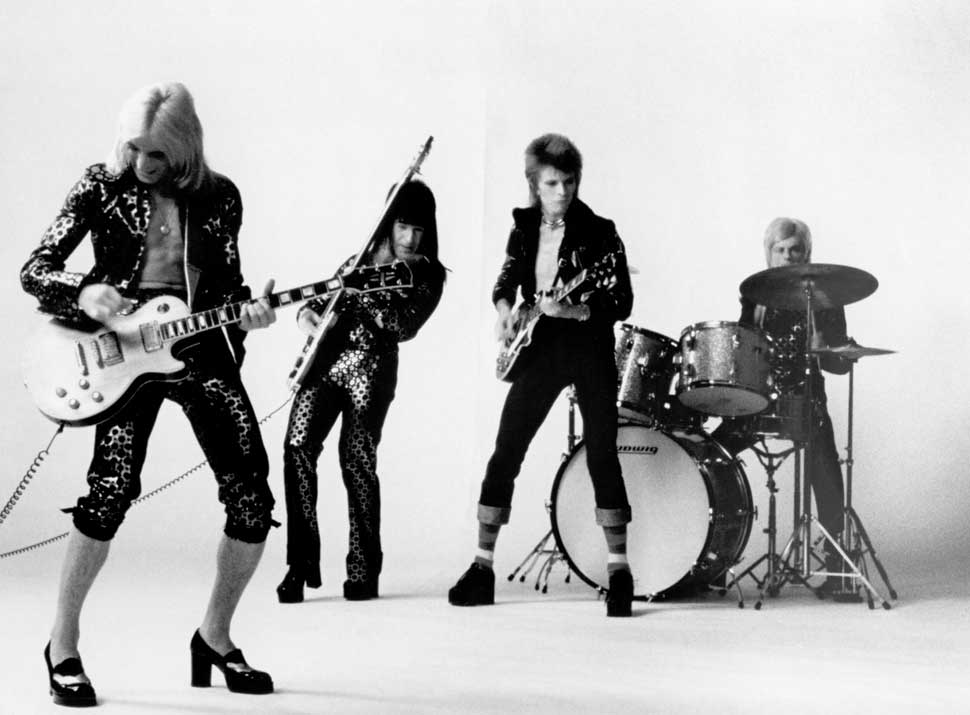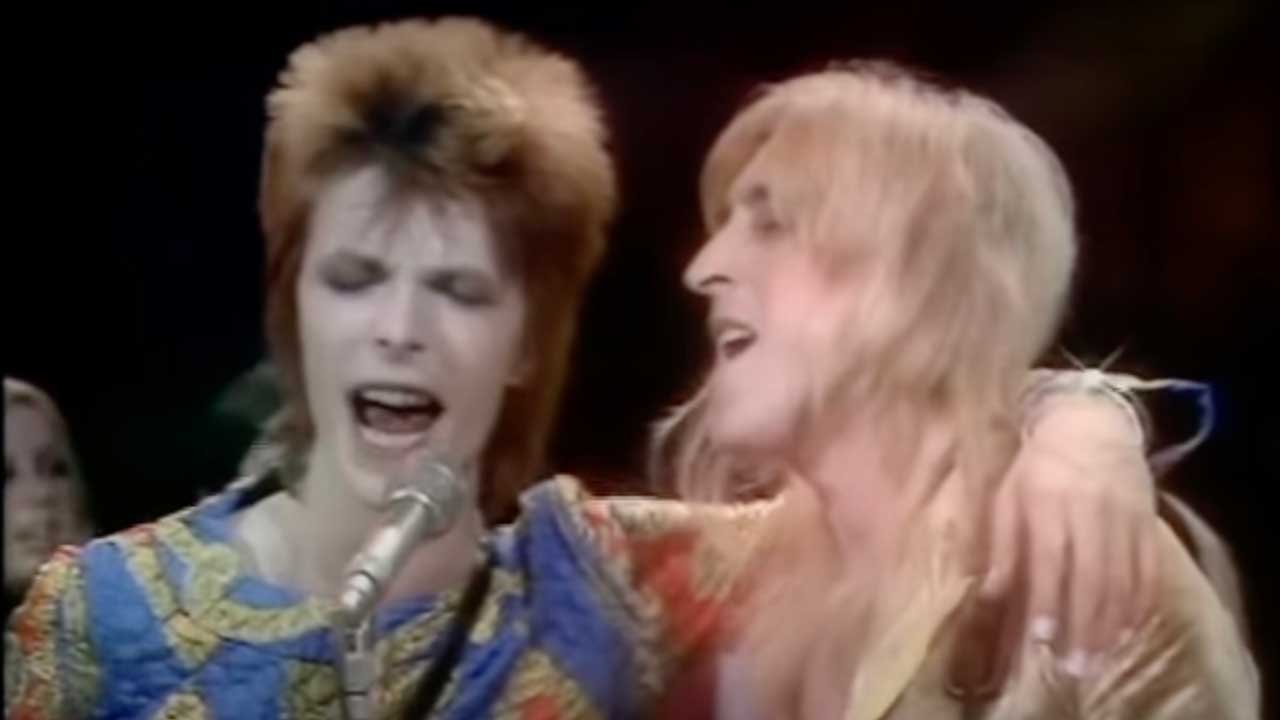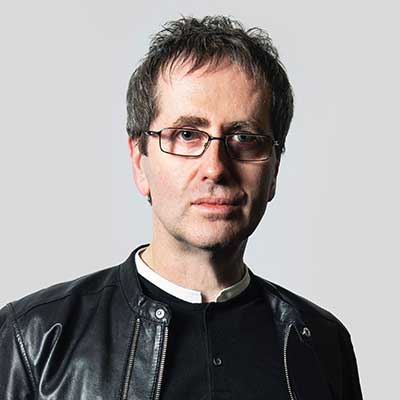When it comes to iconic television performances, David Bowie’s rendition of his Starman single on the Top Of The Pops of Thursday, July 6th, 1972 takes some beating.
While widespread reports of Elvis Presley’s trick pelvis had seduced no less than 82.6% of U.S. television viewers to tune into his Ed Sullivan Hound Dog in ’56 and significant quantities of forewarned kids were already screaming at The Beatles as they too conquered the American heartland via Sullivan in ’64, Bowie’s conquest of the U.K. appeared to come out of nowhere.
Bowie wasn’t a relatively unknown quantity in the summer of ’72, he was worse than that. He was a former one-hit wonder who’d been widely written off or simply forgotten. Space Oddity, perfectly timed to coincide with the ’69 moon landing had been and gone, and three years was a very long time in the old money.
But in the interim (over the course of no less than four singles that entirely failed to chart), Bowie had grafted, transformed himself via a series of truly exceptional albums (The Man Who Sold The World, Hunky Dory, and the most recently released The Rise And Fall Of Ziggy Stardust And The Spiders From Mars) into a one-man vision of the future.
Bowie had already loaded the starting pistol that would kick off the seventies. And he chose to fire it on the long-established jewel in the crown of UK popular music broadcasting, Top Of The Pops. Except he didn’t. He’d already pulled its trigger, to a relatively muted response, the previous month.
While the mainstream record-buying public had been busily grafting at work, Bowie and his band (popularly referred to as The Spiders) had cancelled a gig in Coventry on the 15th of June to fly up to Manchester and debut Starman on something called Lift Off with Ayshea.
Lift Off was a Granada-produced early glam-era TOTP-styled pop show aimed at children and aired in a distinctly adult-unfriendly after-school slot, presented by singer/U.F.O. actress Ayshea Brough (who Bowie had previously hooked up with on the continental TV circuit while promoting Space Oddity in ’69).
Bowie and the Spiders performed in front of dangling cardboard stars of various colours, in a near clone of their TOTP performance broadcast exactly three Thursdays later. Everybody was dressed exactly the same. The only fundamental difference was that, on this occasion, Granada elected to hand the task of introducing Bowie’s groundbreaking pansexual glam rock statement to a school cap-wearing puppet owl by the name of Ollie Beak.
You may well scoff, but in his day, Beak, along with his floor mop/smart-talking dog hybrid partner Fred Barker enjoyed a similar level of celebrity to Ant and Dec.
Unfortunately, despite occasional reports to the contrary, the footage of Bowie’s near legendary appearance on Lift Off, during the course of which he gives the children watching at home ample encouragement to ‘lose it’, ‘use it’ and indeed ‘boogie’ gives every indication of having been lost.
Which is a shame. Especially for ITV. Though not so much for the BBC. Speaking of whom…
July 6, 1972 marked Bowie’s third appearance on the corporation’s Top Of The Pops.
In October ’69 he’d appeared to promote Space Oddity (a proper pot-boiler that was originally released the previous July - Starman itself had been unleashed in April before finally making it to Lift Off in June). On the second occasion, in May ’71, he’d played piano with Peter Noone, as the ex-Herman’s Hermits vocalist promoted his own (U.K. no.12) version of Bowie’s Oh! You Pretty Things.
The TOTP performance was filmed in the vast, 6,000 square feet, Studio 8 at BBC TV centre in Shepherd’s Bush, West London the night before it was broadcast. After their first run-through in stage clothes they adjourned to the BBC bar where Bowie met Lulu, who was also appearing on the show promoting her Even If I Could Change single - as were The New Seekers (Circles), Gary Glitter (Rock And Roll (Part Two)) and The Sweet (Little Willy). Lulu and Bowie hit it off to such an extent that they went on to enjoy a brief romantic liaison. He even produced and appeared on her versions of The Man Who Sold The World and Watch That Man (recorded during the ’73 sessions for Pin-Ups and released as a single that peaked at U.K. number three the following February).
Bowie and the Spiders (guitarist Mick Ronson, bassist Trevor Bolder and drummer Mick ‘Woody’ Woodmansey finally recorded their Starman performance at approximately 9.20pm. The quartet were augmented for the performance by ex-Tucky Buzzard keyboard player Nicky Graham, who went on to write such ‘classics’ as I Owe You Nothing for Bros and Let’s Get Ready To Rumble for PJ & Duncan (a pair of juvenile Novacastrian actors, now more widely known as the 21st century’s aforementioned answers to Ollie Beak and Fred Barker, Ant and Dec). The actual piano on the backing track that Bowie and band were to mime along to, had been recorded at Soho’s Trident studios on June 29th, and been provided by future Brand X keyboardist Robin Lumley.
No owl being available, the band were introduced by then Radio One Breakfast Show Disc Jockey Tony Blackburn (who’d made Bowie’s previous single - Changes from Hunky Dory - his Record Of The Week the previous January).
And so, with the mawkish strains of Dr Hook & The Medicine Show’s Sylvia’s Mother video still fresh in their ears, the viewing public were treated to arguably the most influential three minutes and 55 seconds ever to have been broadcast on British television.
Bowie’s wearing an eye-bogglingly colourful quilted jumpsuit, red boxing boots with green laces, a blue 12-string acoustic guitar and a coquettish half-smile. His other-worldly bright orange coxcomb haircut, created in February by Bowie’s mum Peggy’s hairdresser, Suzy Fussey of the Evelyn Paget hair salon in Beckenham, is a combination of three different haircuts (eat your heart out, Paul Weller) picked out from various hairdressing magazines by David and wife/manager/muse Angie Bowie. It’s a blow-dried vertical puffball at the front that’s razored sleek at the back.
A mullet?
How very dare you.
It’s the most copied hairstyle of its time, widely adopted as a badge of androgynous individuality and wilful weirdness. But back to the TOTP stage, Bowie’s aura of otherworldliness is further accentuated by the paralysed muscle in the iris of his left eye that leaves its pupil permanently dilated. It’s a condition known as anisocoria, the result of a boyhood fight with school friend George Underwood that gives the (wrongful) impression that Bowie boasts two different coloured eyes.
Meanwhile, unusually set up in front of his band mates, elfin drummer Woody Woodmansey, in pink satin blouse, boasts exactly the same Suzy Fussey Ziggy cut as Bowie, but it’s untinted. Mousy, even. There was only ever going to be one star on this stage. Unless…
Mick Ronson, looking like a blonde Adonis in shimmering gold one-piece threads and gold Gibson Les Paul looks impossibly beautiful. And as Starman’s first verse draws to its close he sidles up to Bowie, who casually, iconically, drapes his arm around his shoulders during the first, octave-leap enhanced chorus (its origins revealed that August at Finsbury Park’s Rainbow Theatre, where Bowie revealingly sings ‘There’s a Starman, over the Rainbow’.”).
The pair swap sides twice during the performance, Ronson so relaxed he even exchanges words with Bolder during the second verse that finds the pair standing briefly shoulder to shoulder. Bolder meanwhile offsets his black coxcomb with implausibly long sideburns that have, since Lift Off, been peroxided white and sprayed silver. It’s an extraordinary look that, on any other stage, would have surely stolen the show.
After Bowie points straight down the camera lens in the second verse, crucially smashing the fourth wall to involve his teenaged constituency personally on the line ‘I had to phone someone so I picked on you’, the second chorus sees Bowie go in for a second, more lengthy Ronson arm drape, for the benefit of any potentially outraged/sexually awakened viewers that may have missed it the first time around.
So entirely moved by how well the song appears to be going over, Bowie forgets to mime along with its extended Hey Jude-indebted ‘La-La-La-La-La' coda, opting instead to enthusiastically cajole the lumpen, tank-topped, flared everything, quintessentially seventies studio audience into clapping along. Though largely in vain.
Dissolve-fade to Blackburn, who is, characteristically, grinning like an entire wheel of cheese.
History has been made.

Directly after stepping down from the studio podium, the band walked back to their dressing room, closed its door behind them and, dropping their cool demeanour, squealed with unrestrained delight. And then, it being the seventies tucked into quarter-full plastic cups of warm white wine, cans of Watney’s Red Barrel and reassuringly curled-up BBC sandwiches.
Cheese and/or ham? Obviously.
So how did it go over with the kids at home?
“I immediately put on some of my older sister’s make-up,” remembers The Cure’s Robert Smith, “I loved how odd it made me look, and the fact that it upset people. You put on eyeliner and people started screaming at you. How strange, and how marvellous.”
”I was hooked.” says Ian McCulloch, “The Top Of The Pops performance changed lives. In 1972, I’d get girls on the bus saying to me, ‘Eh la, have you got lippy on?’ Until he turned up it was a nightmare. All my other mates at school would say, ‘Did you see that bloke on Top Of The Pops?’ He’s a right f*****, him!’ And I remember thinking, ‘You pillocks’, as they’d all be buying their Elton John albums, and Yessongs and all that crap. It made me feel cooler.”
“To say it stood out is an epic understatement.” Gary Numan recalls, “Even as a hardcore T.Rex fan I knew it was special... In 1972, I had a haircut like Dave Hill out of Slade with the really high fringe. I didn’t want it, but I was particularly badly behaved that year, so my mum did it to punish me. Shortly after that I got into Bowie, so I had it dyed and spiked as best I could, but it never really went right.”
“I just couldn’t believe how striking he was,” says Siouxsie, “That ambiguous sexuality was so bold and futuristic that it made the traditional male/female role-play thing seem so out-dated. Bowie was the catalyst who’d brought a lot of us, the so-called Bromley Contingent, together. And out of that really small group of people a lot happened.”
And what of the boys in the band? They watched it as it was broadcast from their shared domicile at Haddon Hall in Beckenham: “Everybody thought it was great”, recalled human sideburn Trevor Bolder later, “And it was very, very different. Plus, of course, we were on Top Of The Pops. We’d finally done it. We were all young kids… It was great.”

